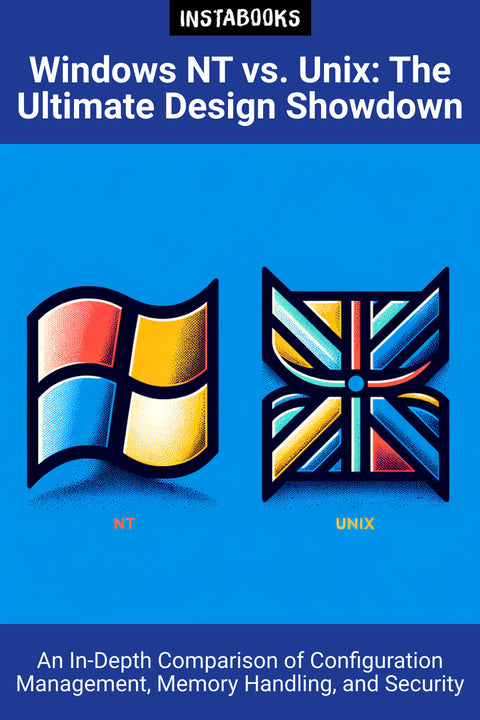
Windows NT vs. Unix: The Ultimate Design Showdown
An In-Depth Comparison of Configuration Management, Memory Handling, and Security
Included:
✓ 200+ Page AI-Generated Book
✓ ePub eBook File — read on Kindle & Apple Books
✓ PDF Print File (Easy Printing)
✓ Word DOCX File (Easy Editing)
✓ Hi-Res Print-Ready Book Cover (No Logo Watermark)
✓ Full Commercial Use Rights — keep 100% of royalties
✓ Publish under your own Author Name
✓ Sell on Amazon KDP, IngramSpark, Lulu, Blurb & Gumroad to millions of readers worldwide
Introduction to Windows NT and Unix
In the evolving landscape of operating systems, two giants stand out: Windows NT and Unix. Understanding the intricacies of these platforms is not just for tech enthusiasts; it's essential for IT professionals, developers, and decision-makers in the technology sector. This book introduces you to the central themes of configuration management, memory management, security features, and internationalization, providing a holistic comparison of these two remarkable systems.
Configuration Management
Windows NT revolutionized the way configurations were managed by introducing a centralized registry system. This facilitated streamlined application development and user system tuning. Conversely, Unix systems historically relied on a myriad of configuration files leading to inconsistencies. Recent advancements in Unix, such as XDG and dconf in Linux distributions, have shown a shift towards more centralized approaches.
Memory Management
The approach to memory management varies significantly between the two. Windows NT employs a per-process memory management system which helps in avoiding thrashing, ensuring efficient use of resources. Conversely, Unix systems, with their global memory management strategies, focus on swapping to maintain performance. This book delves into these methods, exploring how each system achieves data efficiency.
Security Features and Internationalization
Security is paramount in operating systems. Windows NT has long been praised for its robust, centralized security model, offering a C2-capable rating. Unix systems, including modern iterations like Linux, continue to evolve, improving upon their security features. The book also covers the internationalization efforts within both systems, highlighting NT's early adoption of UTF support, making it a leader in accommodating diverse languages.
Shared Attributes
Despite the differences, NT and Unix share common ground in certain features like virtual memory and portability. Both systems employ demand-paged virtual memory, optimizing physical memory use. While NT was crafted with enterprise-level robustness, Unix's simplicity and portability have made it a favorite among developers worldwide. This book explores these shared elements, providing insights into the collaborative evolution of operating system design.
Table of Contents
1. Introduction to Operating Systems- The Evolution of OS Design
- Key Players in the Field
- The Importance of System Architecture
2. Configuration Management
- Windows NT's Centralized Approach
- The Unix Way: Flexibility and Complexity
- Modern Solutions in Configuration
3. Memory Management Strategies
- Understanding Memory Allocation
- Windows vs. Unix: A Detailed Analysis
- Future Trends in Memory Handling
4. Security Features: A Comparative Study
- Windows NT's Robust Security Model
- Evolving Security in Unix Systems
- Modern Security Challenges
5. Internationalization and Globalization
- Early Innovations in NT
- Unix’s Journey to Global Usability
- The Future of Global OS Design
6. Virtual Memory and Optimization
- The Science Behind Virtual Memory
- Efficiency in NT and Unix
- The Role of Virtual Memory in Performance
7. Portability Across Platforms
- NT's Enterprise-Ready Design
- Unix's Portable Simplicity
- Case Studies in Portability
8. Interfacing with Hardware
- Windows NT’s Hardware Integration
- Unix’s Modular Approach
- Balancing Compatibility and Performance
9. User Interface and Experience
- The NT Graphical Edge
- Unix’s Command-Line Power
- User-Centric Design Trends
10. Application Development Considerations
- API and Developer Tools
- Cross-Platform Development
- Predicting the Future of Application Design
11. Networking Capabilities
- Windows NT Networking Features
- Unix Networking: A Historical View
- The Evolving Landscape of Networked Systems
12. Conclusion and Future Directions
- Summarizing Key Insights
- Predictions for OS Innovation
- The Ongoing Evolution of Operating Systems
Target Audience
This book is ideal for IT professionals, software developers, system administrators, and technology enthusiasts eager to understand the comparative design elements of Windows NT and Unix operating systems.
Key Takeaways
- Grasp the fundamentals of configuration and memory management in Windows NT and Unix.
- Explore the security features and internationalization capabilities of both systems.
- Understand the similarities in virtual memory and portability across platforms.
- Learn about the historical evolution and future trends in operating system design.
- Access in-depth insights into both Windows NT and Unix's approach to operating system architecture.
